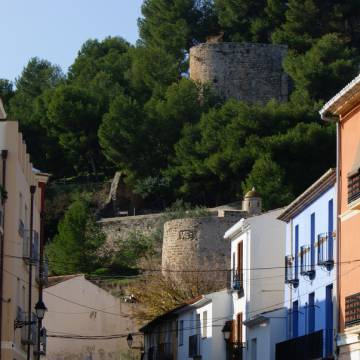Port and "Baix La Mar" quarter
Starting point: Tourist Office (Plaza Oculista Buigues 9).
In this monumental itinerary, we will visit the port of Dénia and the old sailors quarter Baix La Mar.
From the Tourist Office (Plaza Oculista Buigues, 9) we head towards the port, reaching the Seafront, where the "Explanada Cervantes" (Cervantes Esplanade) is located, named so, after the famous writer Miguel de Cervantes' landing in Denia after his captivity in Algeria, recognizable by its typical Palm trees. At the end of the Esplanade we can see the MONUMENTO A CERVANTES (Monument to Cervantes), on the same esplanade and then the MONUMENTO AL CLIMA (Climate monument) that reminds us of the privileged climatic conditions of Dénia with an annual average of 20º C.
Behind the Climate monument, we will struck by the building of the "antiguas atarazanas" (establishment, to build or repair boats) or "LES DRASSANES", of important historical value, since these were the shipyards in the 13th c. although later reforms were carried out in the 18th c., where a hotel is currently located.
Opposite stands one-stored building. It is the old "lonja de pescado" (fish market), current MUSEO DEL MAR (Sea Museum).
Currently an adjacent building, more modern, with very straight lines, inaugurated in 1997, is LA LONJA (the current fish market). where the auction is performed in an automated way (electronically).
At 16:00 hours approximately the unloading is made and the auction begins from 16.30 h. From the windows located on the first floor we can observe the development of it. We can also buy the fish in the shop on the ground floor.
* Annually, a BIOLOGICAL STOP takes place for one month each year. During these dates, only fish from "tresmall" vessels that do not stop biologically and fish from external guilds will be auctioned at 14:00 instead of 17:00; and the sale will continue at 5 p.m.
The importance of the fishing port of Dénia is highlighted, thanks to the great quality and variety of fish that arrives there. Furthermore, we can also buy fish from 17.00 h until 20.00 h aprox.
After the new market, we continue our itinerary and find a small pier with small boats. It is the PUERTO DEPORTIVO LOCAL (Local Marina). Up to 590 moorings are available in this port, for boats of up to 8 m in length and between 2-3 m in draft.
We can also visit the "mercadillo de primavera" (spring and summer flea market) that is set up along the promenade next to the local port. We sell jewelry, gifts, leather goods, textiles, etc. Every day: from 18h to 24h.
From here we have the option of heading to the Escollera Norte and stroll through the area of the Puerto Deportivo El Portet (Marina El Portet), and the Estación Marítima (Maritime Station), or walk along the seafront, where a wide range of terraces of restaurants is located and enter the fisherman's ancien quarter BAIX LA MAR, characterized by the low height of buildings and its narrow streets and little squares, such as the "Plaza de Sant Antoni" or the well-known "Placeta de la Cruz", which is recognized because there is a cross located in the middle of the square.
In the middle, between the promenade and the Raset we see various sculptures, such as the sculpture of "Bous a la Mar" commemorating one of the most representative festivals with the greatest tradition in Dénia which is the festival of "Bous a la mar", declared of national tourist interest, Held in the first half of July. We also see the Monumento al Ancla, which shows us an anchor found in the waters of Denia and pays homage to the great fishing tradition of Denia.
On the "escollera norte" (north breakwater), towards the marina El Portet and the Estación Marítima (maritime station): From the Local Marina, we will take a walk that will lead us to the Puerto Deportivo EL PORTET, where you will find nautical sports, leisure and restaurants as well as spectacular views of the castle and surroundings, and the ESTACIÓN MARÍTIMA, with ferries transporting voyagers and goods from Dénia to the Balearic Islands since Dénia is the nearest continental point to the island of Eivissa, only 55 miles away).


